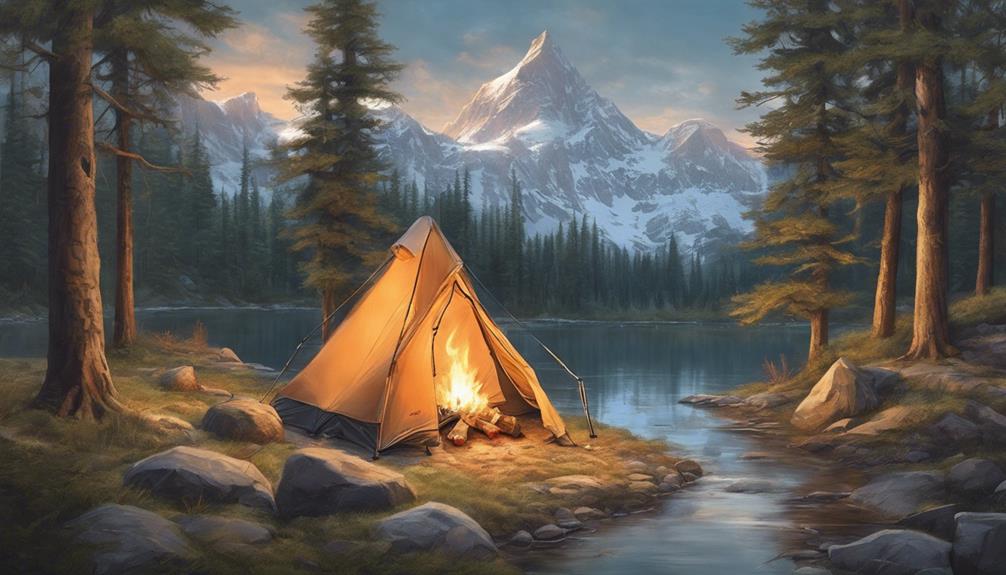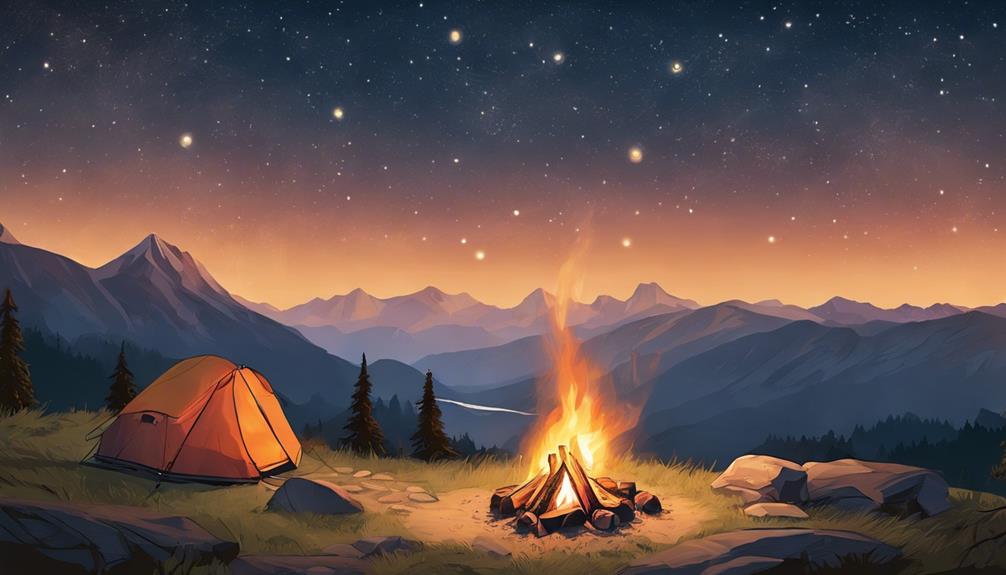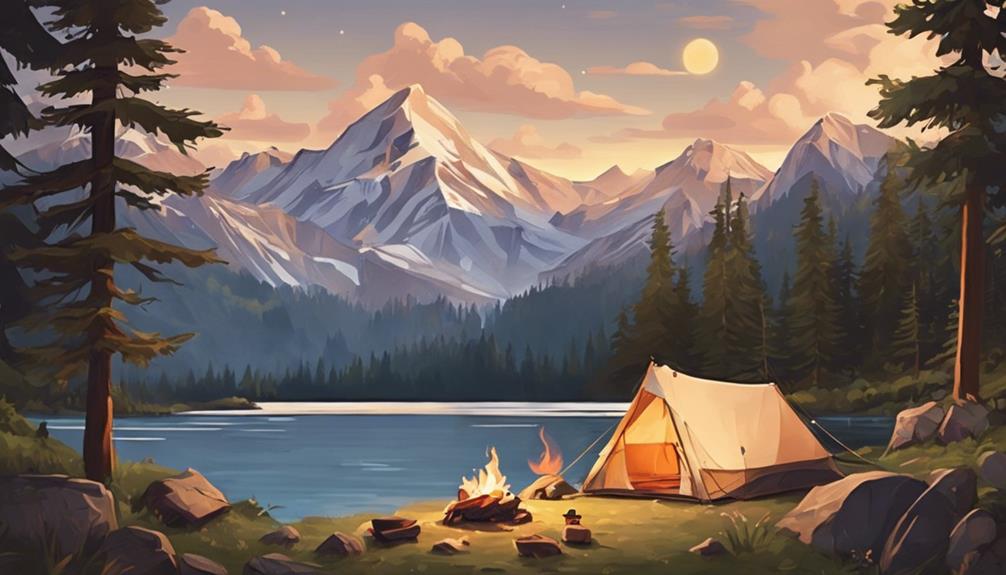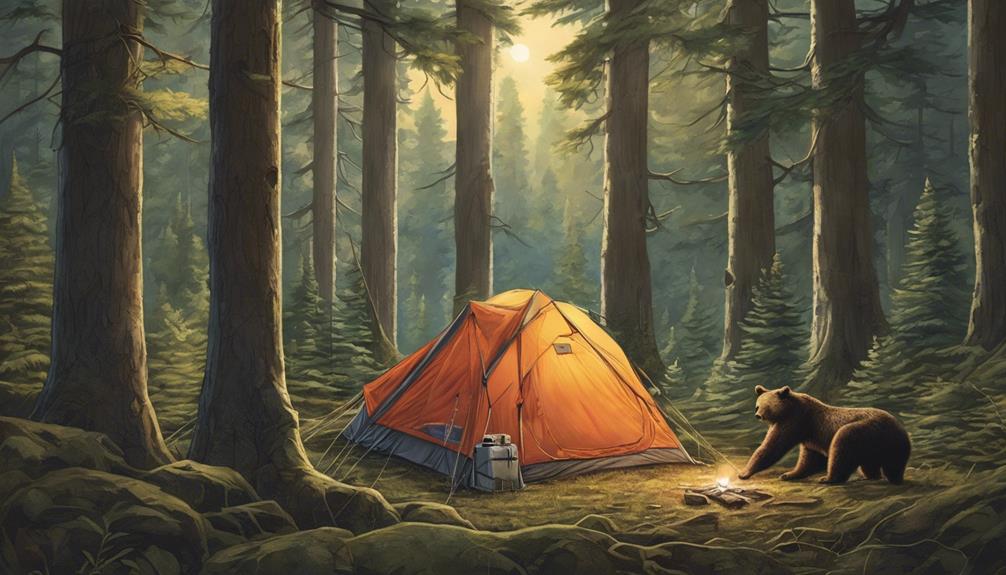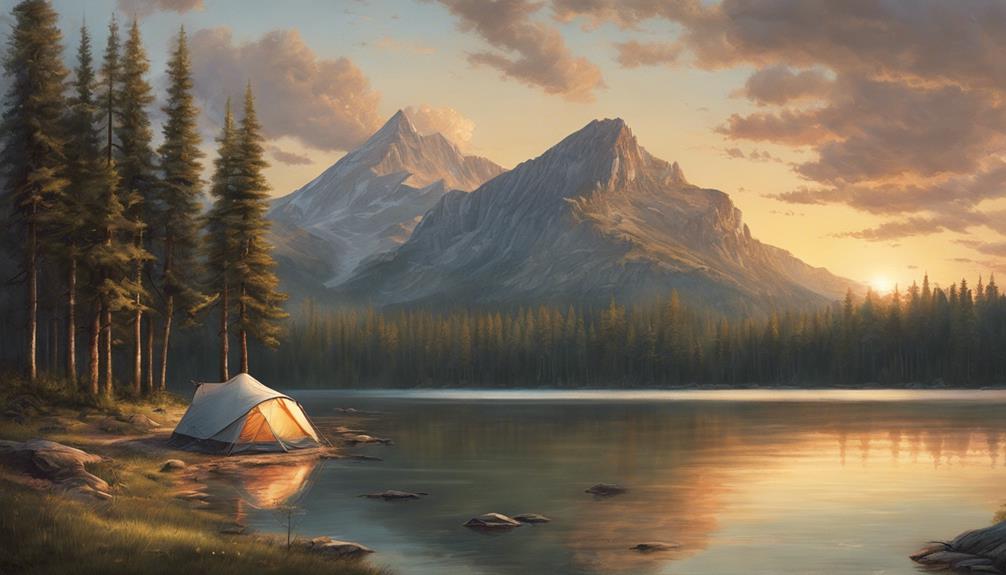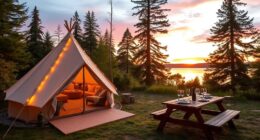When embarking on a solo camping adventure, it is crucial to choose the right campsite with essential amenities and safety precautions in mind. Packing wisely is also important. Properly setting up your tent by selecting a suitable location and securely anchoring it will guarantee a peaceful night’s sleep.
Being knowledgeable about campfire safety, meal planning, hydration, navigation, wildlife awareness, emergency preparedness, and adhering to Leave No Trace principles enhances your camping experience. These tips lay a strong foundation for successful solo camping adventures.
Key Takeaways
- Choose a campsite with amenities and safety in mind.
- Pack light with essentials like a sleeping bag and first aid kit.
- Properly set up your tent for comfort and stability.
- Follow campfire safety measures for extinguishing and storing firewood.
- Plan meals, stay hydrated, and prepare for emergencies with necessary supplies.
Choosing the Right Campsite
When seeking the ideal campsite for our outdoor adventure, considering factors such as proximity to water or mountains can greatly enhance the overall experience. For solo camping, selecting a campsite with amenities like designated fire pits, picnic tables, and bathroom facilities is crucial. These amenities not only provide convenience but also contribute to a more comfortable and enjoyable stay.
When scouting for a campsite, it's essential to prioritize safety. Researching the chosen area for potential hazards or the presence of dangerous animals is a wise step to ensure a secure camping experience. Additionally, checking for nearby trails, fishing spots, or recreational opportunities can add value to the chosen campsite.
Choosing a campsite that offers both the beauty of nature and necessary amenities sets the stage for a successful solo camping trip. Whether it's waking up to the sound of a nearby stream or enjoying a sunset against a mountain backdrop, the campsite plays a pivotal role in shaping our outdoor adventure.
Packing Light and Smart

To embark on a successful solo camping trip, our focus now shifts to the art of packing light and smart, ensuring we have all the essentials without unnecessary weight. When preparing for your adventure, packing efficiently is crucial. Opt for a high-quality, lightweight sleeping bag to ensure comfort without adding bulk. A compact first aid kit is essential for safety, so pack one with the basics like bandages, antiseptic wipes, and pain relievers. Prioritize versatile items like a multi-tool that can serve various purposes while taking up minimal space in your backpack. Remember to pack only what you truly need, avoiding unnecessary items that can weigh you down. Here's a handy table to guide you on essential items to pack:
| Item | Importance | Weight |
|---|---|---|
| Sleeping Bag | High | Light |
| First Aid Kit | Critical | Lightweight |
| Multi-Tool | Versatile | Compact |
Setting Up Your Tent Properly
When setting up our tent, we always start by finding a flat spot, free of rocks and debris, to ensure a comfortable night's sleep.
Following the assembly steps carefully, we secure the tent poles and fabric to avoid any mishaps during setup.
Using proper techniques to secure the tent stakes keeps our shelter stable in varying weather conditions.
Tent Location Selection
Surveying the campsite with a keen eye, we search for a flat and level area, essential for ensuring a comfortable and stable sleep during our solo camping adventure. Choosing a spot free from rocks and dead trees is crucial to avoid hazards.
Additionally, identifying natural windbreaks like bushes or trees can shield our tent from strong winds, enhancing our camping experience. Considering the sun's direction helps us prevent excessive heat or glare inside the tent during the day.
Ensuring our tent is on well-drained ground is vital to prevent water accumulation in case of rain. By carefully selecting the tent location, we set the foundation for a safe and enjoyable camping trip.
Tent Assembly Steps
As we prepare to embark on our solo camping journey, the first step towards a successful outdoor experience is mastering the proper assembly of our tent.
To begin, lay out the tent footprint to mark the tent's location and ensure a level surface for setup. Next, assemble the tent poles following the manufacturer's instructions, starting with the longest ones first. Attach the tent body to the poles using clips or sleeves for a sturdy structure. Stake down the tent corners and guylines to prevent shifting in windy conditions.
Tent Securing Techniques
How can we ensure our tent is securely anchored to the ground for a safe and stable camping experience?
First, drive tent stakes into the ground at each corner and along the edges of the tent to provide a solid anchor. Utilize guylines and tensioners to add extra stability, especially in windy conditions.
Placing a ground tarp or footprint underneath the tent not only protects the bottom from damage but also helps to prevent moisture from seeping in.
Ensure the rainfly is correctly attached to offer additional protection against rain and wind. Regularly check and adjust the tension of the tent to keep it secure and stable throughout your camping trip, ensuring a comfortable and worry-free experience in the great outdoors.
Campfire Safety Measures
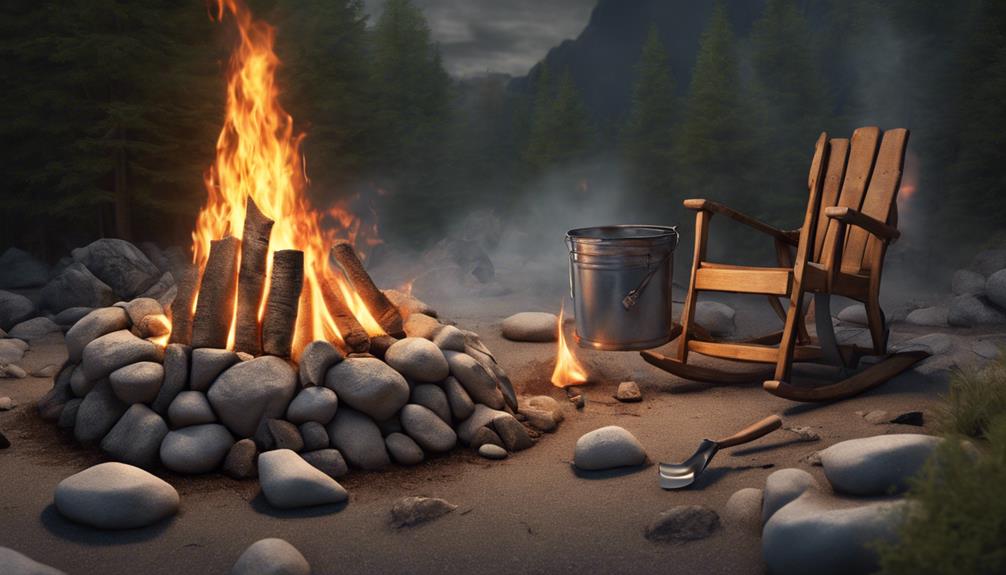
When setting up a campfire, it's crucial to have a bucket of water, sand, or dirt close by for quick extinguishing. Choosing the right firewood and storing it properly can also enhance fire safety.
Extinguishing Campfires Properly
To ensure the safety of all campers and the surrounding wilderness, we always use water to thoroughly extinguish our campfires, making sure to soak every ember, coal, and ash until no heat remains. This practice aligns with the Leave No Trace principles and ensures we leave the campsite as we found it.
Remember to stir the ashes and embers while adding water, cooling down the fire effectively. Burying a fire isn't recommended as it can smolder and potentially reignite, posing a fire hazard. It's crucial to have a bucket of water or a fire extinguisher nearby for quick and efficient fire suppression.
Wait until the fire is cold to the touch before leaving the area to prevent accidental wildfires.
Firewood Selection and Storage
Selecting dry, seasoned firewood is essential for a successful and safe camping experience, ensuring easy ignition and minimal smoke. When it comes to firewood selection and storage, here are three crucial tips to keep in mind:
- Opt for dry, seasoned hardwoods like oak or maple for efficient burning and longer-lasting fires.
- Avoid green or wet wood as it can be challenging to light and generate excessive smoke, affecting your camping experience.
- Store your firewood in a dry, covered area to prevent moisture absorption, ensuring your supply stays ready for use whenever needed.
Meal Planning and Food Storage
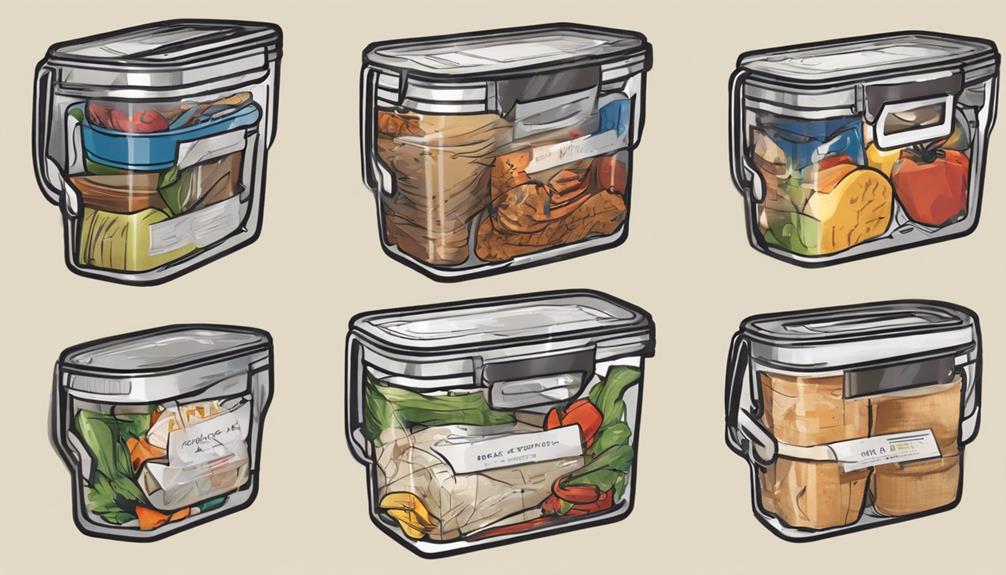
For efficient meal planning and food storage during solo camping adventures, prioritize non-perishable items like canned goods, dried fruits, and nuts. These items are lightweight, easy to pack, and do not require refrigeration, making them ideal choices for extended trips. To help you visualize better, here's a table showcasing some essential food items for solo camping:
| Food Item | Benefits |
|---|---|
| Canned Goods | Long shelf life, no refrigeration needed |
| Dried Fruits | Lightweight, high energy content |
| Nuts | Protein-rich, convenient snack option |
| Dehydrated Meals | Quick and easy to prepare, lightweight |
| Instant Noodles | Simple meal option, minimal cooking required |
When it comes to food storage, using resealable bags or containers can help keep your food organized and easily accessible in your camping backpack. Additionally, investing in compact cooking equipment like a portable stove or camping cookware will make meal preparation a breeze. By following these tips and incorporating these essentials into your camping routine, you'll be well-equipped to enjoy delicious meals while out in the wilderness.
Hydration and Water Purification
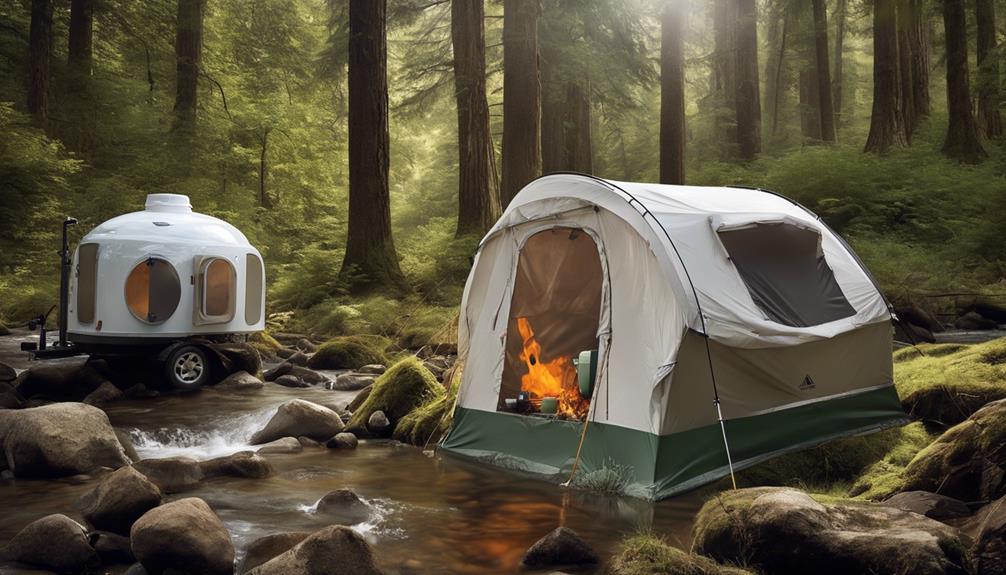
Hydration plays a vital role in sustaining our energy levels and overall well-being during solo camping expeditions. When it comes to staying hydrated and ensuring access to safe drinking water, there are a few key tips to keep in mind:
- Pack Enough Water: Always carry an adequate supply of water to prevent dehydration. Plan your water consumption based on the duration of your trip and the intensity of your activities.
- Invest in a Water Filtration System: Consider bringing a portable water filtration system or purification tablets to make use of natural water sources safely. This won't only lighten your load but also provide a backup in case your water supply runs low.
- Stay Hydrated Throughout: Dehydration can sneak up on you, leading to fatigue and other health issues. Have a hydration strategy in place, such as setting reminders to drink water regularly and monitoring your fluid intake to ensure you're adequately hydrated throughout your solo camping adventure. Remember, water is your best friend in the wilderness.
Navigation and Route Planning
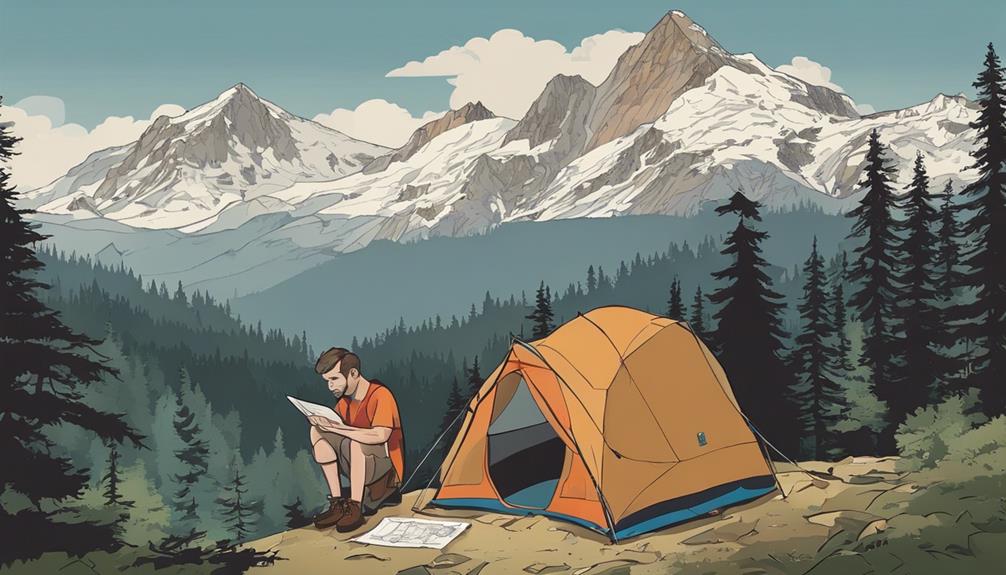
When embarking on a solo camping journey, thorough navigation and route planning are essential for a safe and memorable outdoor experience. To ensure a successful trip, researching trails, obtaining maps, and identifying landmarks are crucial steps. By considering potential obstacles such as water crossings and steep climbs during route planning, you can better prepare for the journey ahead.
Here is a table to guide you through the essentials of navigation and route planning:
| Navigation and Route Planning Tips |
|---|
| Research Trails |
| Obtain Maps |
| Identify Landmarks |
| Consider Obstacles |
When venturing into the wilderness solo, it is imperative to be aware of wildlife presence and pack necessary deterrents like bear spray. Additionally, staying prepared with communication devices and emergency plans is vital for safe navigation. As seasoned campers, we understand the importance of meticulous planning to navigate the great outdoors confidently and securely.
Wildlife Awareness and Safety
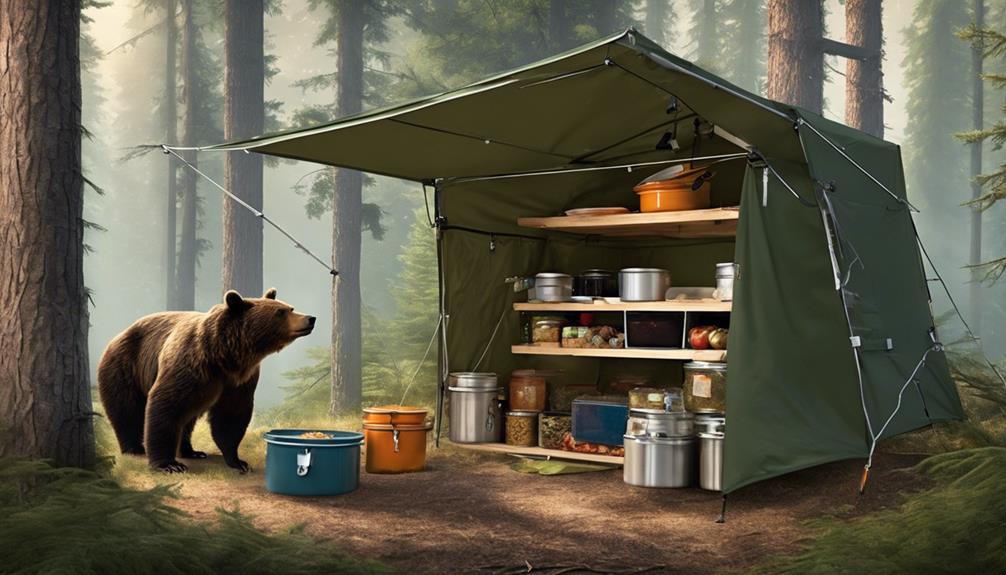
Navigating the wilderness with a keen eye for wildlife behaviors and habitats is fundamental for ensuring a safe and enriching camping experience. Understanding the local wildlife and their habits is crucial to avoid potential encounters while camping.
Here are three essential tips for wildlife awareness and safety:
- Carry Bear Spray: When venturing into areas where encounters with wildlife, such as bears, are possible, always have bear spray or wildlife deterrents readily accessible. These tools can serve as a last line of defense in case of unexpected wildlife interactions.
- Be Aware of Food Storage Regulations: Familiarize yourself with food storage regulations in the area you're camping. Properly storing food and following guidelines can prevent attracting wildlife to your campsite, reducing the risk of dangerous encounters.
- Make Noise While Hiking: While exploring the wilderness, make noise as you move to alert animals of your presence. This simple action can help avoid surprising wildlife and minimize the chances of unexpected encounters.
Emergency Preparedness Kit
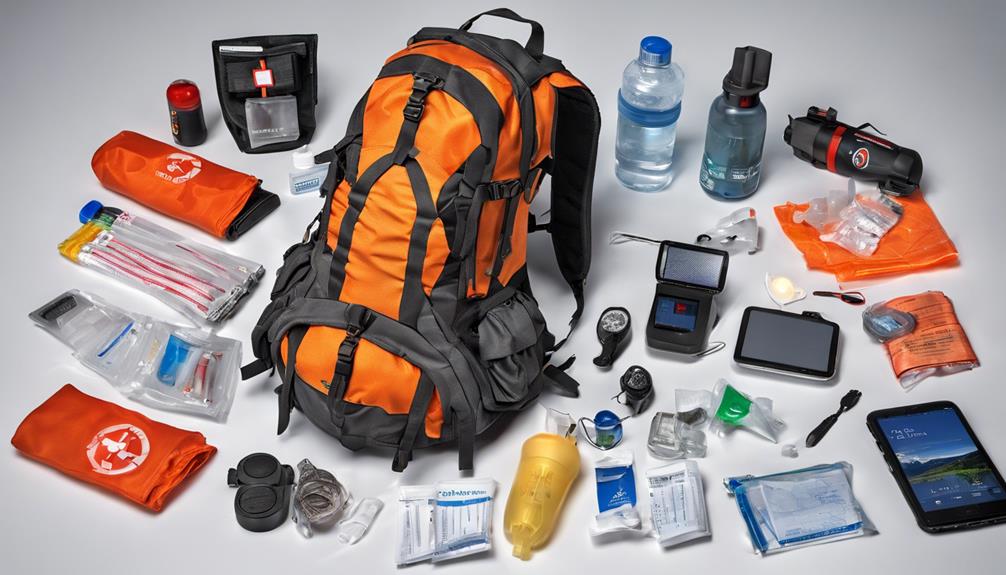
In preparing for solo camping, assembling an emergency preparedness kit is essential to ensure readiness for any unforeseen situations that may arise in the wilderness.
When venturing out alone, it's crucial to pack items like emergency shelter, fire starters, and signaling devices. An emergency shelter, such as a lightweight tent or a thermal blanket, can provide protection from the elements in case you need to spend an unexpected night outdoors.
Fire starters, like waterproof matches or a reliable lighter, are essential for warmth, cooking, and signaling for help. Signaling devices such as a whistle or mirror can assist in alerting others to your location in case of emergencies.
Additionally, consider including items like a map, compass, and GPS device in your kit to help you navigate and communicate your whereabouts. Customizing your emergency preparedness kit based on the specific risks of your camping area will further enhance your safety and preparedness in the great outdoors.
Leave No Trace Principles
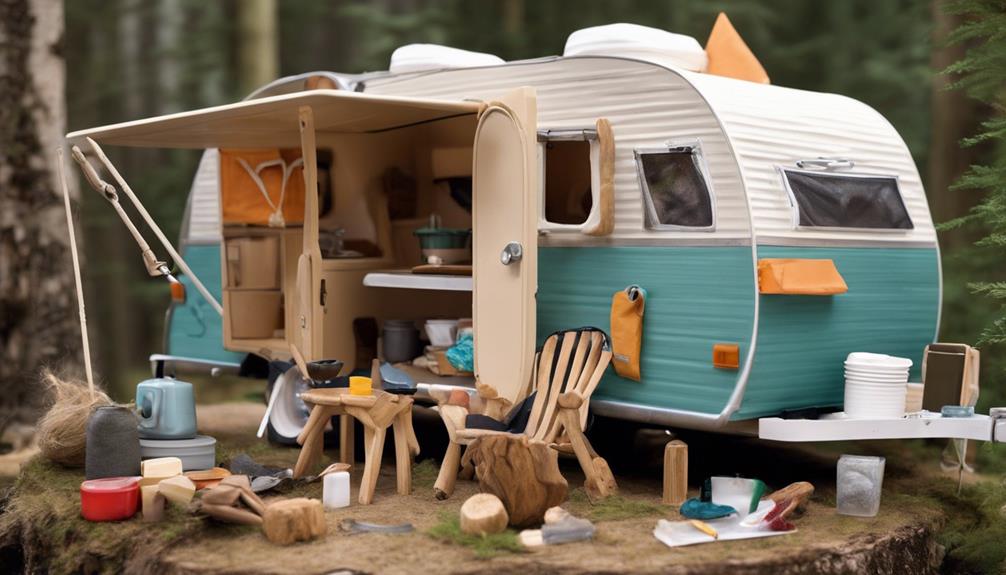
Embracing the Leave No Trace principles ensures minimal environmental impact during our solo camping adventures, preserving the natural beauty for future generations to cherish. As responsible outdoor enthusiasts, we must adhere to these guidelines to ensure sustainable outdoor recreation.
Here are three key practices to follow:
- Pack Out Trash: Always carry a trash bag and pack out all your garbage, including food scraps and leftover packaging. Leaving no trace means leaving no litter behind.
- Respect Wildlife: Keep a safe distance from animals and observe them from afar. Avoid feeding wildlife as it can disrupt their natural behaviors and diets.
- Leave No Trace: Refrain from altering the environment around you. Avoid picking plants, moving rocks, or creating new trails. Leave natural features as you found them to maintain the ecosystem's delicate balance.
Frequently Asked Questions
What Do You Need for Camping Beginners?
For camping beginners, we need essential gear like a tent, sleeping bag, first aid kit, food, and water supplies. Understanding campsite selection criteria is crucial for safety and comfort.
Basic knowledge of route planning, communication, and safety measures is essential. Weather preparedness is key for a successful trip.
Focusing on learning essential skills, packing the right gear, and following safety measures ensures a successful camping experience.
What to Do While Solo Camping?
While solo camping, we enjoy exploring the great outdoors, immersing ourselves in nature's wonders, and embracing the peace and solitude it offers.
Activities like hiking, fishing, stargazing, and documenting our experiences through photography or sketching enhance our connection with the wilderness.
Reflecting on our thoughts and emotions in the tranquility of nature provides moments of clarity and introspection, allowing us to unwind and appreciate the freedom of solitude.
Is It OK to Go Camping Alone?
Absolutely, going camping alone can be a fantastic experience if done safely. By following proper protocols, communicating plans, and being well-prepared, solo camping can offer a sense of independence and adventure.
It's important to inform someone of your whereabouts and check in periodically for added safety. With the right gear and precautions, solo camping can provide solitude and self-discovery in nature, away from the hustle and bustle of daily life.
How Do I Prepare for My First Time Camping?
When preparing for our first camping adventure, we focus on researching the area for hazards, creating a gear checklist, practicing equipment setup, planning meals, and informing someone of our itinerary for safety.
These steps help us feel confident and ready for the trip. By being thorough and organized in our preparations, we can ensure a smooth and enjoyable camping experience.
What Are the Essential Tips for Solo Camping for Beginners?
When it comes to solo camping tips & essentials for beginners, planning is key. Research your location, pack light but don’t skimp on essentials like a reliable tent and camp stove. Practice setting up your gear before you go. Let someone know your itinerary and make sure to have a first aid kit on hand.
Conclusion
In conclusion, solo camping can be a rewarding and enriching experience, but it requires careful planning and preparation. By choosing the right campsite, packing smart, setting up your tent properly, practicing campfire safety, planning meals, being aware of wildlife, preparing for emergencies, and following Leave No Trace principles, you can ensure a safe and enjoyable adventure in the great outdoors.
Remember, a well-prepared camper is a happy camper. So go out, explore, and embrace the wilderness with confidence and excitement!

